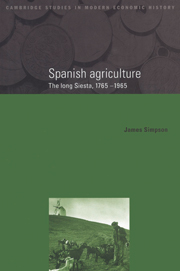Book contents
- Frontmatter
- Contents
- List of illustrations
- List of tables
- Acknowledgements
- Note on the regional division of Spain
- Abbreviations and conventions
- Introduction
- Part I The relative backwardness of Spanish agriculture
- Part II Traditional technologies and market opportunities, 1765–1880
- 3 Agricultural growth and stagnant technology
- 4 Agricultural specialisation and the growth of markets
- Part III The limits to technical change, 1880–1936
- Part IV Markets and institutions, 1880–1936
- Part V The State and the end of traditional agriculture
- Conclusion
- Appendix Estimates of agricultural output and consumption in nineteenth-century Spain
- Bibliography
- Index
3 - Agricultural growth and stagnant technology
Published online by Cambridge University Press: 04 December 2009
- Frontmatter
- Contents
- List of illustrations
- List of tables
- Acknowledgements
- Note on the regional division of Spain
- Abbreviations and conventions
- Introduction
- Part I The relative backwardness of Spanish agriculture
- Part II Traditional technologies and market opportunities, 1765–1880
- 3 Agricultural growth and stagnant technology
- 4 Agricultural specialisation and the growth of markets
- Part III The limits to technical change, 1880–1936
- Part IV Markets and institutions, 1880–1936
- Part V The State and the end of traditional agriculture
- Conclusion
- Appendix Estimates of agricultural output and consumption in nineteenth-century Spain
- Bibliography
- Index
Summary
… Spanish agriculture is still the agriculture of the fifteenth century: an agriculture which plants one year and leaves fallow the next because of the lack of mineral fertilisers; of litanies sung because of the lack of irrigation; of pack animals because of the lack of local roads; an agriculture of scratch ploughs, of illiterate labourers, of money at 12 per cent, of the iniquitous sales tax (the consumos), of miserable harvests of five or six grains for each one sown, of the hungry farmer … a slave to a mortgage and his patron (cacique). (Costa, 1911e, p. 122)
Prior to the 1880s, agricultural imports were negligible except in years of major harvest failures. Even at the turn of the twentieth century, when imports were temporarily much more important, Spain was still 94 per cent self-sufficient in wheat, 87 per cent in maize and 100 per cent in potatoes, wine and olive oil. Consequently, the population increase of some 10 million between 1712/17 and 1900 was fed essentially on domestically produced food. In this chapter and the next, I examine how traditional agriculture was able to increase output with few changes in land and labour productivity.
In the first part of this chapter I argue that cereal production was increased by extending the area cultivated, rather than improving yields.
- Type
- Chapter
- Information
- Spanish AgricultureThe Long Siesta, 1765–1965, pp. 61 - 79Publisher: Cambridge University PressPrint publication year: 1996



